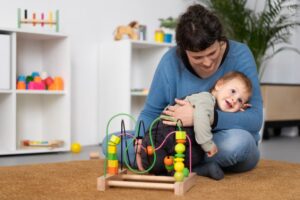
Do you know why every teenager still remembers “Ba Ba Black sheep…” so perfectly? Is it because melody creates memory? Or because music finds its way directly into the soul. This is not a recent discovery that can be seen from the words of Plato, who states that “Music is a more potent instrument than any other for education.” It strongly impacts people at any age, especially the younger ones.
Early childhood is called the prime age for a child’s brain development. The brain is malleable in its childhood and rhythms and harmonies in this age create life-long impacts in maintaining the brain’s health and aging. Children can recognize and differentiate amongst sounds from an incredibly early age. One of the reasons for this ability is that perceiving and enjoying sounds is a human trait with which we are born. Harmonies have been used for ages to heal, for education, for therapies, and much more. It is like a nourishment for our soul, just as food is to the body.
Directly Beneficial?
Yes, immediate positive responses are noticed by neurologists and child specialists when children are exposed to different types of rhythm. Some of them are as follows:
- The awareness of the child increases along with their eyesight and attention span.
- Motor skills and the sense of direction in the child develop faster.
- Their vocabulary, expressing perceptions, and sensory abilities emerge.
- The magical effect of this therapy also improves memorizing and organizing skills; these skills are highly noticeable when the child grows.
- Beats and rhythm have the power to make children sad, happy, and angry, and even calm them enough to sleep.
Hundreds of scientific research and case studies are easily accessible for parents to comprehend the story of how these intangible melodies impact and transform children.
The Ear and Brain Game
We are gifted with a flawless auditory system that connects our ears to the brain by birth. The sounds we hear throughout our lifetime are transmitted from our ears to the head office in the form of neural signals. The details are never-ending, but here we get to know something fascinating. After measuring by EEG, the results conclude that the processing ability of children and their classification of different tones and sounds are more powerful than the kids who are not exposed to any kind of melody.
Engulfed in Melody
Music surrounds our children everywhere, knowingly, or unknowingly, and rhythm is present in nature. The birds sing, water gushes and flows, leaves swish, air howls, and cattle and other animals around us produce sounds in a rhythm. Therefore, it is a fact that music is everywhere. The child’s perception of music is different from what adults think when they listen to the same tone. The youngest infants and even the baby in its mother’s womb receive music tones. Parents who enjoy and listen to soft tunes and rhythms with their little ones also create a stronger bond with their kids. Even if parents do not see sudden improvements in their children, they will indeed witness wonders in the long run.
Music in Education
Educational activities are created everywhere with the help of melodies. They are primarily aimed to cater to children of all ages to help them learn and memorize.
Infants can recognize the melodies far before they understand the meaning of the words in them. Slow and soft tones can be calming for babies of this age; they make them sleep peacefully at night, and subconsciously mold their nature to become soft and calm.
Toddlers often shake with the rhythm. Repetition, in words, is simply what they love. They laugh and clap their hands when they recognize the repeated verses.
Preschoolers try to sing along with what they remember. However, they are unaware of their voices and just keep chanting the nursery rhymes. Repetition in the rhymes helps them to retain words and develop their vocal skills.
When children reach their school-going age, a sense of taste in music is built. However, they like to learn with fun and rhymes. In addition, music helps them to create memories from home and school.
At a Quick Glance
The purpose of rhythm and harmony in this world is for the betterment of human beings. Therefore, it contributes a lot to developing a child’s mental state. Melody ignites multiple developmental paths in the child’s brain, especially the skill of reading, linguistic acquisition, and expressing feelings and emotions.
Knowing that music has a direct impact on the brain’s plasticity and neural functions, the Brainnovation tool kit includes instruments such as a metronome that helps a child’s mind work on a rhythm making their training session more efficient as well as more fun. Adding such elements to a child’s education can not only make their learning experience more entertaining but also more effective.






